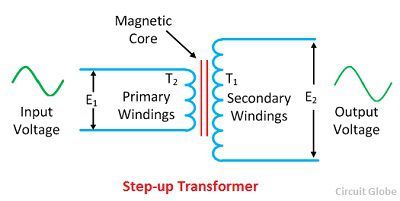Step-up Transformer
A transformer in which the output (secondary) voltage is greater than its input (primary) voltage is called a step-up transformer. The step-up transformer decreases the output current for keeping the input and output power of the system equal.
Considered a step-up transformer shown in the figure below. The E1 and E2 are the voltages, and T1 and T2 are the number of turns on the primary and secondary winding of the transformer.
 The number of turns on the secondary of the transformer is greater than that of the primary, i.e., T2 > T1.Thus the voltage turn ratio of the step-up transformer is 1:2. The primary winding of the step-up transformer is made up of thick insulated copper wire because the low magnitude current flows through it.
The number of turns on the secondary of the transformer is greater than that of the primary, i.e., T2 > T1.Thus the voltage turn ratio of the step-up transformer is 1:2. The primary winding of the step-up transformer is made up of thick insulated copper wire because the low magnitude current flows through it.
Applications – Step-up transformer is used in transmission lines for transforming the high voltage produced by the alternator.The power loss of the transmission line is directly proportional to the square of the current flows through it.
Power = I2R
The output current of the step-up transformer is less, and hence it is used for reducing the power loss. The step-up transformer is also used for starting the electrical motor, in the microwave oven, X-rays machines, etc.
Step-down Transformer
A transformer in which the output (secondary) voltage is less than its input (primary) voltage is called a step-down transformer. The number of turns on the primary of the transformer is greater than the turn on the secondary of the transformer, i.e., T2 < T1. The step-down transformer is shown in the figure below.
 The voltage turn ratio of the step-down transformer is 2:1. The voltage turn ratio determines the magnitude of voltage transforms from primary to secondary windings of the transformer.
The voltage turn ratio of the step-down transformer is 2:1. The voltage turn ratio determines the magnitude of voltage transforms from primary to secondary windings of the transformer.
Step-down transformer is made up of two or more coil wound on the iron core of the transformer. It works on the principle of magnetic induction between the coils. The voltage applied to the primary of the coil magnetise the iron core which induces the secondary windings of the transformer. Thus the voltage transforms from primary to the secondary winding of the transformer.
Applications – It is used for electrical isolation, in a power distribution network, for controlling the home appliances, in a doorbell, etc.

Great effort?
That was such an awesome content to read and going through it.Thanks for such a good information.
This is a very nice post especially for students like me who don’t want to study about transformer.
MAGNIFICIENT EXCELLENT JOB